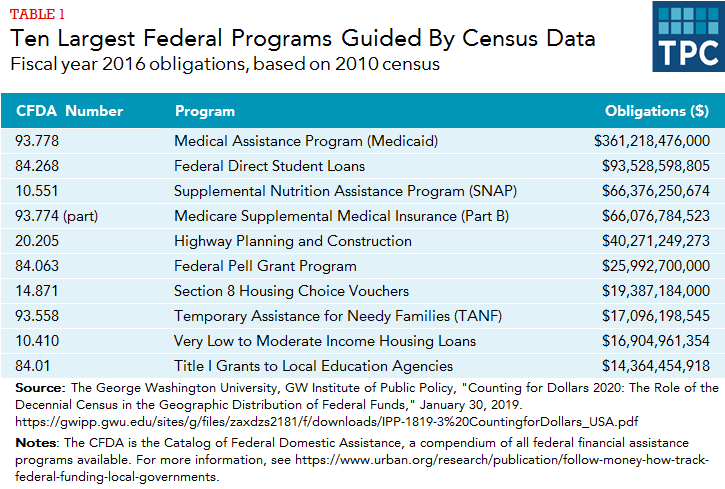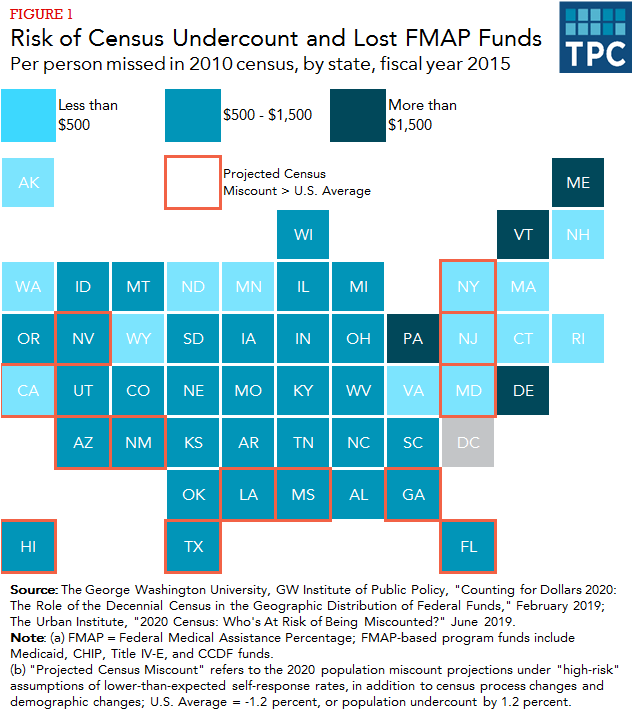The voices of Tax Policy Center's researchers and staff

The US Supreme Court’s decision to leave a US citizenship question off the 2020 Census (for now) has focused unusual attention on the usually staid, boring, and perhaps mysterious attempt to count every person in the US every ten years.
Researchers (including some from the Census Bureau itself) and politicians had worried that the citizenship question would discourage immigrant and Hispanic/Latino participation. Population counts directly affect the redrawing of US Congressional maps and thus political representation.
But the Census also affects up to $900 billion in grants, direct payments, loans, and loan guarantees that the federal government distributes annually to states and individuals. That’s because the federal government relies on census data in whole or in part to calculate how to distribute those funds.

For example, do you live in a rural area eligible for help building and upgrading wastewater treatment facilities? Or an urbanized area eligible for transit grants? The US Department of Agriculture and US Department of Transportation can’t even define rural or urbanized areas without population thresholds derived from the decennial census. (There actually are numerous definitions of “rural” for programs that arguably serve the same purpose, but that’s another story.)
Federal agencies also use population, housing, and demographic data – all from the census or related products – in formulas to allocate funds. For example, the US Department of Housing and Urban Development apportions Community Development Block Grants based on area population, population growth, poverty, housing overcrowding, and age of housing stock (again, imperfectly).
Even when federal funds are not apportioned by formula, census data still make their way into decisions to award funds to specific projects or calculations of interest rates on federal loans. They are also used in independent evaluations of how well federal programs are performing and what could be improved.
Medicaid may be the program most affected by potential census undercounts. The federal government reimburses states for their Medicaid costs based on state per capita personal income relative to US per capita personal income. The higher a state’s per capita income, the lower its federal medical assistance percentage, or FMAP, though the feds always contribute at least 50 percent of Medicaid costs.
Here’s why the census matters for Medicaid: if you undercount a state’s population, you overstate how much income each resident has, all else being equal. This makes a state look economically better off than it is, and its reimbursements for Medicaid (and a host of other federal programs that depend on the FMAP) would go down. The only exceptions: comparatively well off states like California and New York that already are at the 50 percent minimum federal share of Medicaid costs.
My Urban Institute colleagues in a project led by Diana Elliott have calculated that the already troubled 2020 Census could undercount the US population by 1.22 percent nationally and as much as 2 percent in states like California and Texas
George Washington University’s Andrew Reamer has calculated that, all else being equal, a 1 percent undercount in 2010 would have cost Texas $1,161 per missed person in Medicaid and other FMAP-reliant program support. For small states and states where Medicaid programs were more generous, the figure could be higher.

It is time that Congress take a fresh look at federal grant formulas like FMAP. I and others have written about how they do a crummy job taking account of state need, fiscal capacity, and costs. But first, the government needs to do the best job it possibly can counting the nation’s population. Today’s decision makes that easier.
Posts and comments are solely the opinion of the author and not that of the Tax Policy Center, Urban Institute, or Brookings Institution.
